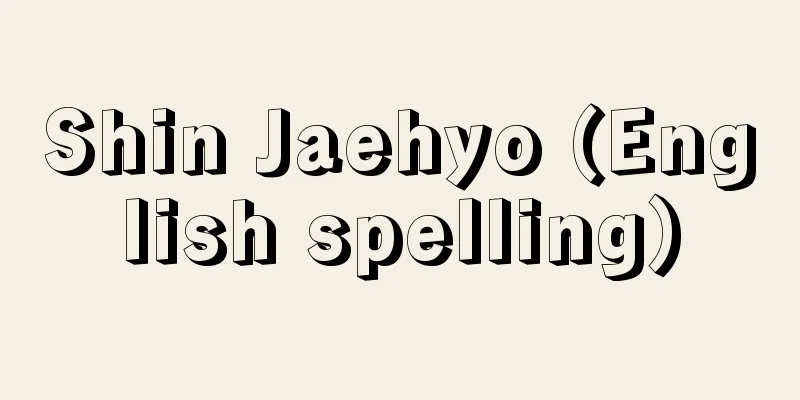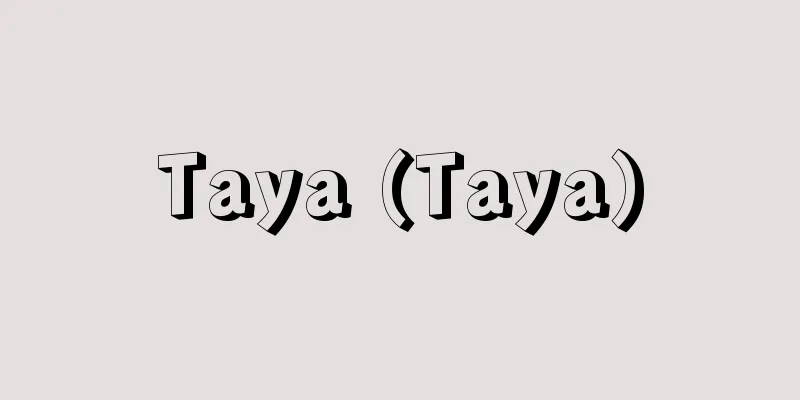Dim sum - Tenshin

|
It refers to Chinese snacks, and there are some that serve as a simple meal, some that are served in the middle of a meal, and some that are used in the same way as Japanese sweets. The term dim sum originated in the Tang Dynasty, and until the beginning of the Yuan Dynasty, it referred to a small meal before breakfast (when people had two meals a day), but during the Yuan Dynasty, all small meals between meals came to be called dim sum. Therefore, when Buddhism was introduced to Japan, the word dim sum and some of its meaning were also introduced, and it has since developed into a wide variety of contents and is generally loved not only in China but also in Japan. [Nomura Machiyo] ClassificationDim sum can be classified based on its contents into mochi (bing), kao (kao), tuan (towan), rice (fan), congee (cho), fruit (kuotsu), and other processed products. [Nomura Machiyo] rice cakeThey are unrelated to Japanese mochi (rice cakes), and are made from wheat flour. Examples include spring cakes (chunbin), big cakes (tabin), small cakes (xiaobin), moon cakes (yuebin), and sesame cakes (chima subin). Steamed buns (mantou), noodles (mien), and dumplings (chiaotzu) are also classified as mochi. (1) Spring cakes are made by mixing wheat flour with warm water, egg white, and a small amount of oil and kneading it until it is as soft as an earlobe. After resting for a while, it is rolled out thinly, and one side is oiled all over and folded in half. It is rolled out again thinly to 1.5 mm and cut into circles about 10 cm in diameter. When it is fried on both sides on a hot plate with oil, each piece will come apart into two pieces, which are then rolled up with various spring vegetables and sweet miso paste, and eaten by hand. (2) For the large mochi, the wheat flour is kneaded and rolled out, one side of which is coated with oil, and then sesame seeds and shredded green onions are added. Salt is sprinkled on, the mochi is folded in half, cut into large pieces, and baked on a hot plate before being torn apart with fingers. During Obon, the mochi (pin) is baked with lotus leaf-shaped lines on the surface and wrapped around offerings, so it is called lotus leaf mochi (hoi e pin). (3) For the small mochi, warm water is added to the wheat flour, kneaded until it is as soft as an earlobe, and rolled out thin and long like a sash. The surface is coated with oil and a small amount of salt, rolled up from both ends and joined in the middle, then stacked and rolled out to a thickness of about 1 cm and cut into 2.5 cm lengths. The corners of each piece are rounded to make a dumpling, black sesame seeds are placed on top, a red dot is placed in the center, and the dumpling is baked on a thick hot plate over low heat. When it is done, it can be peeled off into several slices like a pie, making it easy to eat. Xiao buns are the main staple when eating gao yang rou (roasted lamb). (4) Su buns are made into two types, A and B, depending on the amount of lard added to the flour. Two pieces of A and B are put together, rolled thinly, rolled up from one end, and cut into pieces 1.5 to 2 cm wide. After shaping, the surface is decorated with sesame seeds or almonds, and baked in the oven like a cookie, or deep-fried. Sugar can be added to the flour, and those filled with red bean paste or jam are called su box. [Nomura Machiyo] CakeIt was originally made with rice flour (joshinko), but wheat flour or kudzu starch may be used instead. Chicken egg cake (chitankao) is a steamed castella cake made by lightly mixing well-beaten eggs (with sugar) with joshinko flour and steaming it, and can also be made with dried fruits mixed in. Nian kao (niankao) is a Japanese type of mochi (rice cake), and includes white ones and ones with osmanthus flowers (koihua) (osmanthus flowers), brown sugar, citrus fruits, etc. inside. During the New Year, white rice cakes are fried and eaten with meat and vegetables. [Nomura Machiyo] A dumpling made from rice flour. Jadeite (Huei Tsuoi Touan) is made by mixing rice flour and joshinko flour, steaming it, adding boiled and chopped mugwort, and mixing well to make green dumplings. These dumplings are made in the spring. [Nomura Machiyo] Rice and porridgeDishes using whole grains of rice or other grains include Eight Treasure Rice (pa bao fan) and Steamed Glutinous Rice Chicken (zhong nuo mi chi). The congee is thinner than Japanese congee and is often cooked in soup. Some are made with fish, mung beans, shrimp, or chicken. In China, except in the rice-producing areas in the south, congee is more popular than rice, and various congees are eaten throughout the country, especially for breakfast. (1) Steamed Glutinous Rice Chicken is made by boiling half a chicken in plenty of water with a little salt and sake until it is soft, and using the broth for the soup. Remove the large bones from the chicken and cut it into chunks with the skin still on. The glutinous rice is steamed, and ginkgo nuts, chestnuts, matsutake mushrooms, etc. can also be added inside. The bottom of the bowl is decorated with ham or other ingredients, and chicken skin is cut into chunks and pasted around the outside of the bowl. The rice is then tightly placed inside and covered with a lid and steamed. The dish is then served upside down on the table and topped with hot soup. It is suitable as dim sum at banquets, just like Eight Treasures Rice. (2) Laba Zhou (also known as Wu Wei Zhou) is made on the eighth day of the 12th month of the lunar calendar, mainly in the northern regions of China. It is an elaborate five-grain porridge made with glutinous rice, non-glutinous rice, barley, millet, and sorghum, and various fruits such as walnuts, pine nuts, lotus seeds, dried dates, and chestnuts. December 8th is the festival day when the family eats this rice porridge together, topped with red and white sugar. It is first offered to ancestors and Buddha, and then distributed to relatives and friends. December is also called the Red Moon. [Nomura Machiyo] FruitProcessed fruits and other ingredients. (1) Xinren tofu is a condiment made from apricot seeds. Apricot kernels are thoroughly mashed, the juice strained, solidified with agar, cut into bite-sized pieces, poured over syrup and chilled to be served as dim sum at banquets. (2) Parsley chestnuts are chestnuts that have been peeled, boiled, deep-fried, and then wrapped in sugar candy. They are also called insulits because when picked up with chopsticks, a silver thread is pulled out. (3) Tang fuur are candied jujubes, apples, sweet potatoes, and other candied fruit strung on a skewer and inserted into a straw bag, which is then sold from a handcart. In the past, the candy would sparkle in the sunlight against the clear, blue autumn sky, and was one of the autumn scenes in Beijing. [Nomura Machiyo] Source: Shogakukan Encyclopedia Nipponica About Encyclopedia Nipponica Information | Legend |
|
中国の間食のことで、そのなかには簡単な食事になるもの、一献立の途中に供されるもの、また日本の菓子と同様に用いられるものなどがある。 点心の語は唐の時代に始まって、元の初期ごろまでは朝食(1日2食時代)前の小食をさしたが、元時代に食間の小食をすべて点心というようになった。したがって日本への仏教の渡来と同時に、日本にも点心なることばと、その内容の一部が伝えられ、その後現在までに豊富な種類の内容に発展し、中国はもちろん日本でも一般に愛好されるようになった。 [野村万千代] 分類点心をその内容から分類すると、餅(ピン)、糕(カオ)、(トワン)、飯(ファン)、粥(チョウ)、果子(クオツ)、その他の加工品に分けられる。 [野村万千代] 餅日本の餅(もち)とは関係がなく、小麦粉を原料としてつくられたもので、春餅(チュンピン)、大餅(ターピン)、小餅(シャオピン)、月餅(ユエピン)、芝麻酥餅(チーマスーピン)などがある。饅頭(マントウ)、麺(ミエン)、ギョウザ(餃子(チャオツ))も餅に属する。(1)春餅は小麦粉に温湯、卵白、少量の油を加えて耳たぶくらいの柔らかさに練る。しばらく休めてから薄く伸ばし、片面の全体に油を塗って二つに折る。ふたたび1.5ミリメートルに薄く伸ばし、直径10センチメートルくらいの丸形に抜く。鉄板に油を塗り、弱火でこれを両面焼くと一枚が二枚にはがれるので、これに春の種々の野菜と甜醤(ティエンチャン)(甘みそ)を入れて巻き、手に持って食べる。(2)大餅は前記の小麦粉を練って伸ばして片面に油を塗ったときに、ゴマ、ネギのせん切りを入れ、塩をふって二つ折りにして大形に切り、鉄板で焼いてそのまま指でちぎって食べる。盂蘭盆(うらぼん)のときには、餅(ピン)の表面にハスの葉の形に筋をつけて焼き、精進物を包んで食べるので荷葉餅(ホーイエピン)という。(3)小餅は小麦粉に温湯を入れて耳たぶくらいの柔らかさにこね、帯のように薄く長く伸ばす。表面に油を塗り少量の塩をふって、両端からくるくる巻いて中央であわせ、重ねてこれを1センチメートルくらいの厚さに伸ばして2.5センチメートルの長さに切る。1個ずつその角を丸めて団子状にして上に黒ゴマをつけ、中央に紅のぽちをつけて厚手の鉄板で蓋(ふた)をして弱火で焼く。できあがるとパイのように幾枚にもはがれて食べやすい。小餅はカオヤンロウ(烤羊肉)を食べるときの主食である。(4)酥餅(スーピン)は小麦粉に加えるラードの量の多少によって、AとBの2種類のものをつくり、AとBを二枚あわせ薄く伸ばして片端からくるくる細く巻いて、1.5~2センチメートル幅に切る。形を整えて表面をゴマやアーモンドなどで飾り、クッキーのようにオーブンで焼いたり、あるいは油で揚げる。粉に砂糖を加えてもよく、小豆餡(あずきあん)やジャムなどを中に包んでつくったものを酥盒子(スーホーツ)という。 [野村万千代] 糕本来は米の粉(上新粉)でつくられたが、かわりに小麦粉や葛(くず)粉を用いることもある。鶏蛋糕(チータンカオ)は蒸しカステラのことをいい、上新粉によく泡立てた卵(砂糖入り)を軽く混ぜ合わせて蒸したもので、干果類を混ぜてつくってもよい。年糕(ニェンカオ)は日本の餅(もち)のことで、白いものや、中に桂花(コイホワ)(モクセイの花)、黒砂糖、柑橘(かんきつ)類などを入れたものもある。正月には白い餅と肉、野菜類をともに炒(いた)めて食べるという。 [野村万千代] 米の粉で団子にしたもの。翡翠(フエイツオイトワン)は白玉粉に上新粉を混ぜて蒸し、これにゆでて刻んだヨモギを入れてよく混ぜ、緑色の団子にする。この団子は春につくる。 [野村万千代] 飯・粥米やその他穀類を粒のままで使ったもので、八宝飯(パーパオファン)、蒸糯米鶏(チョンヌオミーチー)などがある。粥は日本の粥(かゆ)よりも薄く、スープで炊くことが多い。中には魚、リョクトウ、エビ、鶏肉などを入れてつくるものもある、中国では南方の米の産地以外では、白飯よりも粥を食することが多く、とくに朝食には中国全土でいろいろの粥を食べる。(1)蒸糯米鶏は、縦半羽の鶏を少量の塩、酒を入れたたっぷりの水で柔らかくなるまで煮て、煮汁はスープに用いる。鶏は大骨を取り除き、皮付きのままぶつ切りにする。糯米(もちごめ)は蒸し、中にぎんなん、栗(くり)、マツタケなどを入れてもよい。どんぶりの底をハムなどで飾り、ぶつ切りの鶏の皮を外側にしてどんぶりの周りに張り付け、中にきっちりおこわを入れてかぶせ蓋(ぶた)をして蒸す。これを食卓に出す器に逆さにあけて、熱いスープをかけて供する。筵席(イエンシー)(宴会席)に点心として、八宝飯と同様に適する。(2)臘八粥(ラーパーチョウ)(別名五味粥(ウーウエイチョウ))は、旧暦12月8日に中国のおもに北方地方でつくられる。糯米、粳米(うるちまい)、大麦、粟(あわ)、コーリャンの粥に、胡桃(フータオ)(クルミ)、松の実、ハスの実、干しなつめ、栗など種々の果子を入れ、くふうを凝らしてつくる五穀の祝い粥である。12月8日はこの粥を家族で食べる節句(せっく)と定められ、紅、白の砂糖をのせて食べる。最初に祖先や仏に供え、親戚(しんせき)や友人に互いに配る。なお12月のことを臘月(ラーユエ)という。 [野村万千代] 果子果物その他を加工したもの。(1)杏仁豆腐(シンレントウフ)はアンズの種子でつくった寄せ物のこと。杏仁(アンズの種子の仁)をよくすりつぶして汁を漉(こ)し取り、寒天で固めて適当に切り、シロップをかけて冷やし、宴席の点心とする。(2)抜絲栗子(パースーリーツ)は皮を除いてゆでた栗を油で揚げ、砂糖飴(あめ)でくるんだもの。箸(はし)でとるとき銀の糸を引くので銀絲栗子(インスーリーツ)ともいう。(3)糖葫蘆(タンフール)はナツメやリンゴ、サツマイモなどの糖包児(タンパオル)(飴だき)を串(くし)に通し、葫蘆(藁(わら)でつくった苞(つと))に挿して攤子(タンツ)(手押し車)で売り歩いているもの。昔は青く晴れ渡った秋空に飴が日差しに輝いて、秋の北京(ペキン)風景の一つでもあったという。 [野村万千代] 出典 小学館 日本大百科全書(ニッポニカ)日本大百科全書(ニッポニカ)について 情報 | 凡例 |
Recommend
Business cycle - English
In a capitalist economy, booms, when economic act...
evergreen thorn
...Native to the western part of mainland China. ...
Venture Business
This refers to small and medium-sized enterprises ...
Katmai [mountain] - Katmai
An active volcano in Alaska, USA. It is 2,047 mete...
Phyllotaxis
...the leaf blade is formed in the upper leaf, an...
America (Kafka)
… In August 1912, he met Felice Bauer, and in one...
Schaffle, AEF (English spelling) SchaffleAEF
...Looking at the development of public finance i...
Chofu
A district of Shimonoseki City in the southwest o...
Lunda
...The kingdom of the Lunda people that once exis...
Rustam (English spelling)
A legendary Iranian hero. His heroic tales form th...
Carambola - Carambola
An evergreen tall tree of the Oxalidaceae family c...
Nguyen Kim Thanh
…Leader of the Vietnamese Communist Party and poe...
Del
...Abbreviation: Del. A small constellation facin...
Active hydrogen
This refers to hydrogen that has become more susc...
Art of Deception
...Also, dangerous tricks such as sticking needle...









